Review
In my previous review of MegaBase 2024 I had promised that I would show here games of past masters in the MegaBase. There is one problem, though. Many of us here already know games of past masters. So what can be new? When I set out to find an answer, I stumbled on a rare work of analysis. And it happened by chance. I was looking for a masterpiece by Nimzowitsch, preferably annotated by the great man himself.
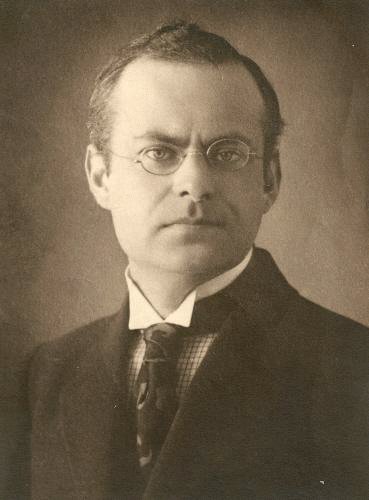
Aron Nimzowitsch (circa 1916) | Photo: Unknown via Per Skjoldager (reproduced with permission) — Lund Chess Academy sells antiquarian chess books (including works on Nimzowitsch)
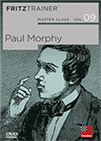 Learn about one of the greatest geniuses in the history of chess! Paul Morphy's career (1837-1884) lasted only a few years and yet he managed to defeat the best chess players of his time.
Learn about one of the greatest geniuses in the history of chess! Paul Morphy's career (1837-1884) lasted only a few years and yet he managed to defeat the best chess players of his time.There were quite a few. What I found instead was an eyewitness report of a World Championship duel by Nimzowitsch and all of it in German! Before we see it all, here is a little background for our young readers.
A hundred years ago Capablanca was the World Champion and the Cuban was invincible. Then came Alekhine and beat him in 1927 after a gruelling struggle to wrest the World Championship title from him. Capa demanded a return match, and Alekhine chose to avoid the same. However, there was a public demand that Alekhine should play a World Championship match and defend his title. Alekhine chose Bogoljubow and played a match with him in 1929. This was an exciting duel in which both players revelled in thrust and counterthrust.

Alekhine and Bogoljubow, photographed during their 1929 match | Sources: audiovis.nac.gov.pl and dgriffinchess.wordpress.com
Alekhine won and when there was a demand for a return match he obliged readily. Unfortunately, this match was a disaster for Bogoljubow and he finished with a poor score (+3-8=15). Dr. Emanuel Lasker was present during the match and authored a short but fascinating book on the match. Later, Fred Reinfeld and Reuben Fine also came up with a title of their own on the match.
A World Championship drama
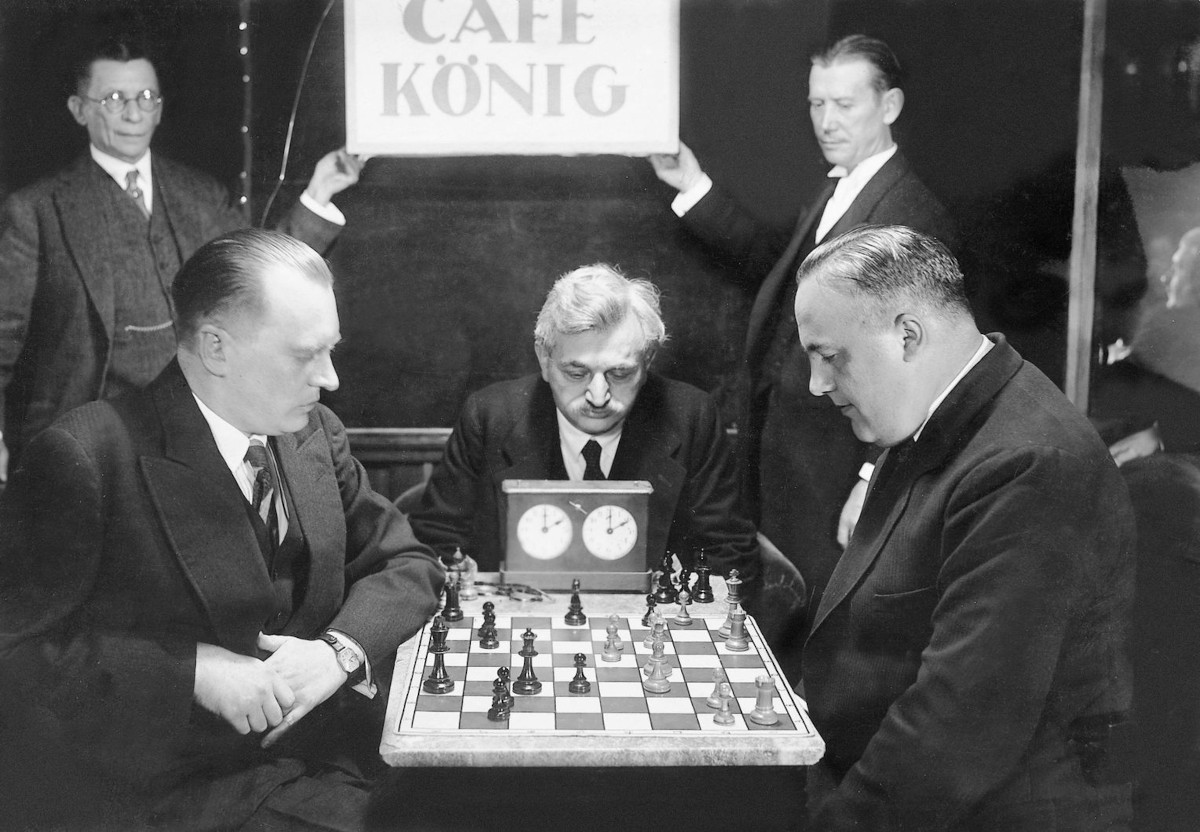
Alexander Alekhine and Efim Bogoljubow during their 1934 match | Source: Amazon
When this game was played, Bogoljubow was trailing far behind in the match. He had missed a number of opportunities and also made terrible blunders. Then this happened.
A telling commentary by a great mind on this World Championship game.
With the benefit of hindsight, let me make a minor point. Nimzowitsch mentions a trap in the opening that does not work. Curiously, Alekhine was also lured by the same trap and gave it up in the end. What did they overlook? Here is a case study from a modern point of view:
What Nikolai Grigoriev saw
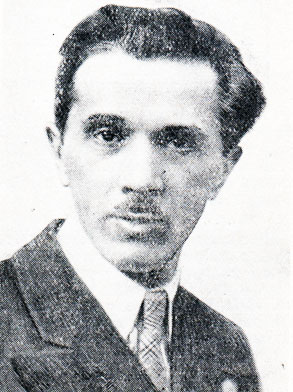
Nikolai Grigoriev
The above analysis does not mean that old masters always saw less. Here is what Nikolai Grigoriev found way back in 1934 when the match took place.
The agony of Bogoljubow
To return to Nimzowitsch, he also offers a dramatic account of this game in the MegaBase:
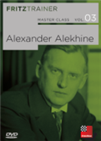 On this DVD GMs Rogozenco, Marin, Müller, and IM Reeh present outstanding games, stunning combinations and exemplary endgames by Alekhine. And they invite you to improve your knowledge with the help of video lectures, annotated games and interactive tests
On this DVD GMs Rogozenco, Marin, Müller, and IM Reeh present outstanding games, stunning combinations and exemplary endgames by Alekhine. And they invite you to improve your knowledge with the help of video lectures, annotated games and interactive tests
The catastrophe that the 21st game between Alekhine and Bogoljubow showed us raises the question: Is Bogoljubow too tired? Or is he suffering physically? Because the two big zeros he scored in well-won positions were not about clean technical endgame finesse, where we are used to Bogoljubow’s inadequacies, but about mistakes in a full-blooded middlegame position.
Since the beginning of the match, indeed, since the reporter has been following chess games at all, he does not remember witnessing such a catastrophe. Against his opponent, who was at times very cocky and at times very nervous, Bogoljubow was given a significant chance early in the game: a well-advanced passed pawn, which was also an extra pawn (Alekhine had sacrificed a pawn and had forgotten to take it back in the heat of the battle — see the note on the 7th move.). This pawn completely paralyzed the opponent’s game. In his desperate need, the world champion tried to advance his e-pawn, but this only led to a fixation of the pawn structure.
What remained of Alekhine's counterplay was eliminated by Bogoljubow with an exchange sacrifice. And then the position of the world champion resembled that of a dying man. All terminally ill, paralyzed and feverish. A correspondent, who was in a hurry, was ready to post a telegram saying “White wins” when the bomb suddenly exploded. The passed pawn, which had now advanced to b7 and held both black rooks prisoner, could of course not be given up under any circumstances. All that was left to do was to pass a bishop (from d2) across c1 to d6 into the heart of Black’s position, at which point Alekhine would have given up.
But how can one describe the horror that gripped the large audience and reporters when Bogoljubow gave up the pawn with his 33rd move? And all because of a terrible hallucination: a bondage that wasn’t a bondage. The opponent, who was just paralyzed, now tears down all shackles, springs out like a spring and suddenly has a perfectly healthy endgame with an exchange up.
Alekhine, who until this liberating moment had sat clinging to his chair with an ashen face and nervous twitches, now leaves his seat and presents himself to the audience, confident of victory. With his right shoulder pulled high, one hand leaning on his hip and his chest out, his posture is again strongly reminiscent of that of the Russian officers. Bogoljubow, on the other hand, is destroyed; his pale face shows great embarrassment alongside despair. He is ashamed in front of the audience.
After the game is stopped, he immediately leaves the restaurant through a back door to reach his room without being seen. We don’t see him again until the following day. He himself begins to talk about the catastrophe that has befallen him. He feels completely tired of chess. He had given simultaneous displays night after night for eight months and only allowed himself 14 days of rest before the start of the match. And that now turns out to be too short. He has thrown away at least six games that were won for him. If he had rested well, the match would have been completely different. We have known him for a long time. It is strange to see this happy and healthy person so sad now. We comfort him as much as possible because we completely understand his chess fatigue. Once after we had completed a three-month tour, we felt exhausted and playing chess became a burden for a while. But eight months on tour — that must be terrible!
- Source: De Telegraaf 1934/JUN/04 | Venue: Karlsruhe
In the same MegaBase you find game 10 of this World Championship match, and it is also annotated by Nimzowitsch. Bogoljubow suffered enormously in Alekhine’s hands. Nimzowitsch offers a moving account of the plight of his friend before he goes on to analyse the game.
One niggling question remained in my mind. Did Bogoljubow himself write an account of this match? As it turned out, he did.

Schachkampf um die Weltmeisterschaft Zwischen Aljechin-Bogoljubow 1934
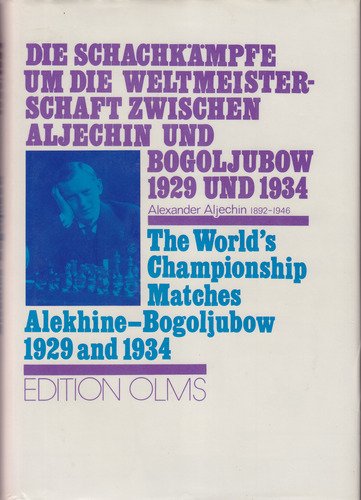
It may also be found in this four-volume work
Then came the next question. Had he also seen the drawing line with 44.Ke2! that Grigoriev had found? He had, but not on his own. In fact, it was G. Normann, a chess player from Leipzig who had independently found the line. In his book on the match, Bogoljubow sportingly gives him the credit.
From a human point of view, the 1934 match is very interesting. Alekhine played a cat and mouse game with Bogoljubow. From a creative point of view, their 1929 match is fascinating. It’s a feast for lovers of combinational play. Both revelled in attack and were extraordinarily resourceful in defence.
Annotations
This brings me to the subject of annotations to games of past masters in MegBase. A number of them are unannotated. Others have annotations of varying length and quality.
Which annotations are best? Those that offer a judicious blend of explanation and analysis. Variations, Informant style, offer signposts and no more. We still need to know why great masters made those moves, good and bad. Engines can always tell us what they overlooked. However, we have to see the circumstances in which the game was played and the state of mind of each player. Seeing the human drama that was played out in these games is an act of imagination.
Following the games in the MegaBase is the first step. Thereafter, one has to supplement one’s understanding with some good reading and, importantly, practice over the board.
Acknowledgement
Thanks to Raymond W. Rozman, Special Collections Librarian, Cleveland Public Library, USA. He located Bogoljubow’s writing in German on the 21st Game of the Match in the quartet on the World Championship Matches 1929 and 1934.
Notes
1) The work in the second photo is a set of four books:
https://www.abebooks.co.uk/servlet/BookDetailsPL?bi=31703309599
2) In 1931 the Soviet master Benjamin Blumenfeld edited an excellent Russian book on the World Championship 1929. Among others, it includes annotations to six games by young Botvinnik. They are worth their weight in gold. He was only 20 at the time!
https://dgriffinchess.wordpress.com/2021/04/10/the-soviet-book-on-the-alekhine-bogoljubow-match-of-1929/
Blumenfeld’s book has also been translated into English.
3) Nikolai Grigoriev (1895-1938) was an authority on the final phase of the game. He composed a number of endgame studies (especially, king and pawn positions). Among others, he inspired young Yuri Averbakh. More on him is here:
https://chesspro.ru/_events/2008/grigoriev.html
Links
1. In a previous review of the MegaBase I dealt with its treatment of three world championship matches:
https://en.chessbase.com/post/megabase-2022-three-epic-matches
2. In another review, I have dealt with the treatment of Carlsen and his peers along with the play of veterans and young talents in the MegaBase:
https://en.chessbase.com/post/megabase-2023-modern-master-play
3. In the last review I have taken examples of Chess in the 21st Century from the MegaBase:
https://en.chessbase.com/post/megabase-2024-review-nagesh-havanur
The ChessBase Mega Database 2024 is the premiere chess database with over 10.4 million games
from 1475 to 2023 in high quality.





























